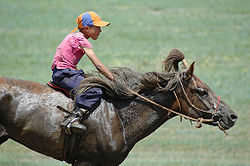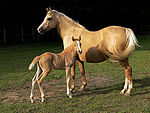- Mongolian horse
-
Mongol Horse 
A Mongol horse (with trimmed mane) in traditional riding gearDistinguishing features small size, genetic variation Country of origin Mongolia Horse (Equus ferus caballus) The Mongol horse (Mongolian Адуу, aduu: "horse") is the native horse breed of Mongolia. The breed is purported to be largely unchanged since the time of Genghis Khan. Nomads living in the traditional Mongol fashion still hold more than 3 million animals, which outnumber the country's human population. Despite their small size, they are horses, not ponies.
In Mongolia, the horses live outdoors all year (at 30°C in summer down to -40°C in winter) and search for food on their own. The mare's milk is processed into the national beverage airag, and some animals are slaughtered for meat. Other than that, they serve as riding animals, both for the daily work of the nomads and in horse racing.
Contents
Appearance
Mongol horses are of a stocky build, with relatively short legs and a large head. They range in size from 12 to 14 hands high and have a cannon diameter of about 8 inches. They have a certain resemblance to Przewalski's Horse. The mane and tail are very long, and the strands are often used for braiding ropes; the tail hair can be used for violin bows. The hooves are very robust, and very few animals are fitted with horseshoes.
Behavior
Mongol horses are frugal, arduous, somewhat wily, and tread safely in rough terrain. In Mongolia, most animals are kept roaming free, and only a small number of riding animals get caught and tethered. Once the animal has become familiarized with carrying a rider, it will be calm, friendly, and very reliable.
The Mongolian saddle is very tall, with a wooden frame. It only allows marginal control of the gait. In most situations, the horse will decide the gait on its own, while the rider is occupied with other tasks (such as herding cattle). Very often, a Mongol horse will choose to canter.
 Child racing at the Naadam festival
Child racing at the Naadam festival
Racing horses with a child in the saddle will run in full gallop over 35 km at a time. They are trained to keep running even after losing their riders. In such a case, they need to be stopped in the finish zone by aides waiting there especially for that purpose.
Breeding history
The exact origins of the breed are hard to determine. Horseback riding has been documented with the nomads of the central Asian steppes since 2000 BC. Tests have shown, that among all horse breeds, Mongol horses feature the largest genetic variety, followed by the tuwinian horses. This indicates that it is a very archaic breed suffering little human induced selection. The data also indicate that many other breeds descend from the Mongol horses.[1][2]
Horses in Mongolian culture
Horses are greatly cherished in Mongolian culture, particularly among the nomads because horses are very useful to people's daily lives and livelihood. Horse racing is the second most popular event in Mongolia, after traditional wrestling. Mongol horses were a key factor during the 13th century conquest of the Mongol Empire. There is a traditional saying in Mongolian: "A Mongol without a horse is like a Bird without the wings". Genghis Khan himself once said: "It is easy to conquer the world from the back of a horse". A horse is a traditional gift to male children when they turn 3 years old. A nomad with many horses is considered wealthy, and having many horses which are also in good shape is considered honorable behavior. Mongols almost never kill their horses for food unless they are in a state of extreme hunger and cattle or sheep are not available. Mongol people individually have favorite horses, each family member has his and her own horse, and some family members value their favorite horses by saving them from working under a lot of pressure.
See also
- List of horse breeds
- Przewalski's Horse
- Horses in East Asian warfare
External links
References
- ^ Udina I.G.: Computer Analysis of D-Loop of Mitochondrial DNA Variation in Asian Horse Breeds. In: The Third International Conference on Bioinformatics of Genome Regulation and Structure (BGRS 2002)
- ^ Tozaki et al.: Microsatellite Variation in Japanese and Asian Horses and Their Phylogenetic Relationship Using a European Horse Outgroup. In: Journal of Heredity 2003:94(5)
Equine Equine science and
management
Equestrianism
and sportGlossary of equestrian terms · List of Equestrian Sports · Horse tack · Bit · Bridle · Saddle · Harness · English riding · Western riding · Driving · Horse training · Horse racing · Equestrian at the Summer Olympics (medalists, venues) · Horse show · EquitationEvolution and history Domestication · In warfare · In the Middle Ages · Horses in East Asian warfare · History of the horse in South Asia · Horses in the Napoleonic Wars · Horses in World War I · Horses in World War II · History of the horse in BritainHorse breeds, types
and other EquidaeList of horse breeds · Wild horse · Feral horse · Stock horse · Gaited horse · Draft horse · Warmblood · Sport horse · List of horse breeds in DAD-ISOther EquusHybridsCategories:- Horse breeds
- Animal breeds originating in Mongolia
Wikimedia Foundation. 2010.
